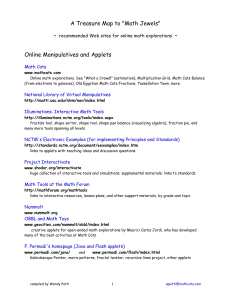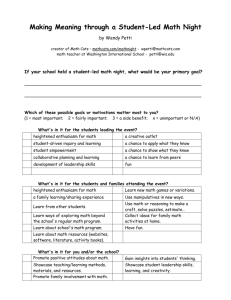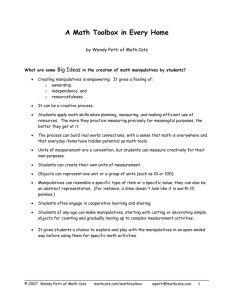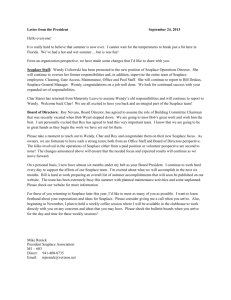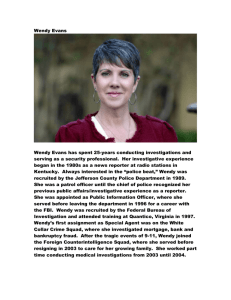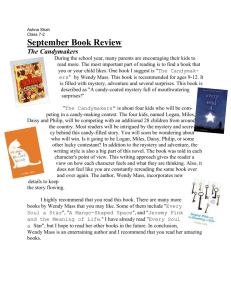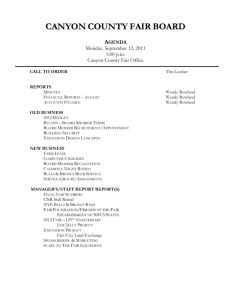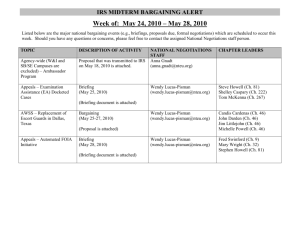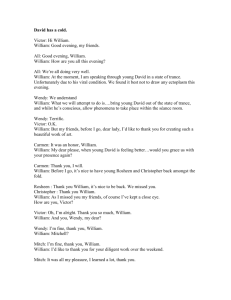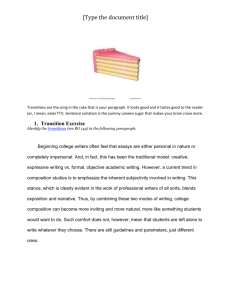Student-Led_Math_Night
advertisement
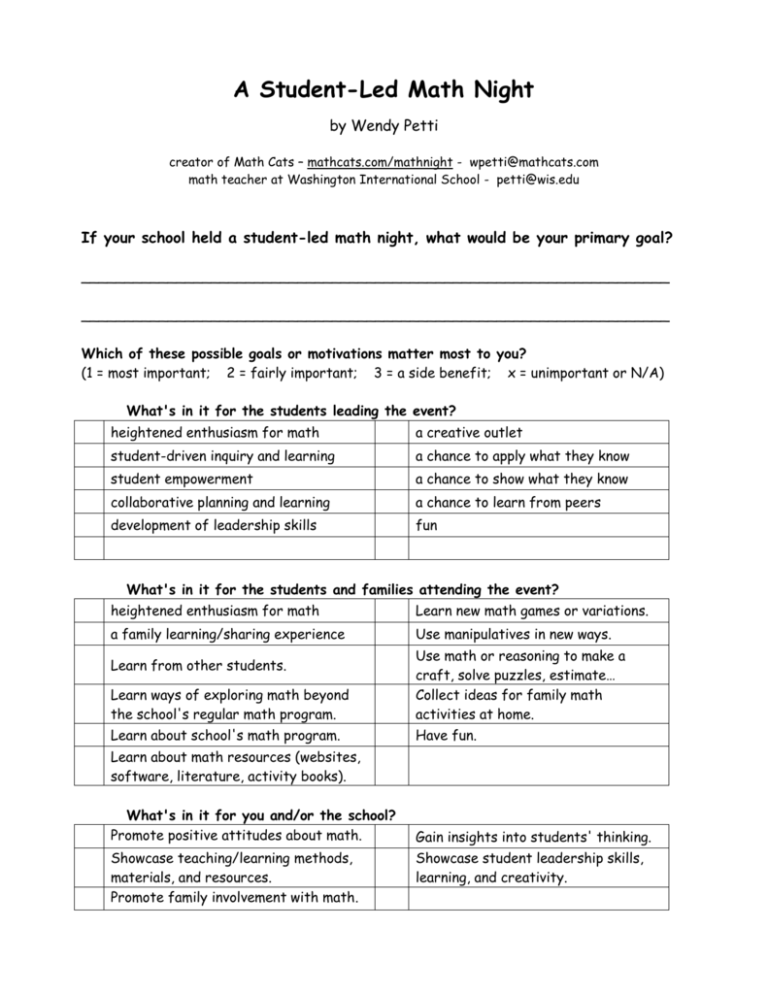
A Student-Led Math Night by Wendy Petti creator of Math Cats – mathcats.com/mathnight - wpetti@mathcats.com math teacher at Washington International School - petti@wis.edu If your school held a student-led math night, what would be your primary goal? ____________________________________________________________________ ____________________________________________________________________ Which of these possible goals or motivations matter most to you? (1 = most important; 2 = fairly important; 3 = a side benefit; x = unimportant or N/A) What's in it for the students leading the event? heightened enthusiasm for math a creative outlet student-driven inquiry and learning a chance to apply what they know student empowerment a chance to show what they know collaborative planning and learning a chance to learn from peers development of leadership skills fun What's in it for the students and families attending the event? heightened enthusiasm for math Learn new math games or variations. a family learning/sharing experience Use manipulatives in new ways. Learn ways of exploring math beyond the school's regular math program. Use math or reasoning to make a craft, solve puzzles, estimate… Collect ideas for family math activities at home. Learn about school's math program. Have fun. Learn from other students. Learn about math resources (websites, software, literature, activity books). What's in it for you and/or the school? Promote positive attitudes about math. Showcase teaching/learning methods, materials, and resources. Promote family involvement with math. Gain insights into students' thinking. Showcase student leadership skills, learning, and creativity. Who's coming? (Which model would work best for your event?) Scope and leadership of the event: One grade level leads an event for all other grade levels of the school. One grade level leads an event for a younger grade level. (There could be several such events at different grade levels throughout the year.) One class leads an event for another class or several classes. Teachers and students join forces to lead an event. (Some activities are teacher-led and some are student-led, or activities are co-led by teachers and students.) As you consider the scope of the event, bear in mind space and parking limitations. Consider starting with a smaller pilot event even if you ultimately want to hold larger events. Family involvement: Each student who attends needs to bring a parent and may also bring siblings. Students may be dropped off without parents. Students may be "adopted" by another family for the evening if parents can't attend. Will students need to stay with family members throughout the event? Plan for a wide range of ages. Siblings might range in age from toddlers to high schoolers. Plan some activities that can engage all ages. What space will you use? multi-purpose room Will there be enough space? Will noise and distractions affect participants' ability to hear instructions and focus on one activity at a time? classrooms on one floor or in one wing Doors can be shut to block out noise if needed. Classroom computers can be used for small-group activities, or families can compete or collaborate using one computer and an LCD projector. A computer lab or cart of laptops can be used. the entire school It helps to give each family a map of activity locations and brief descriptions. The map can be in the form of a "passport" hung around each student's neck. Hanging a festive sign outside each room can add to a fun atmosphere. _____________________________________________________________________________ © 2009 Wendy Petti petti@wis.edu wpetti@mathcats.com www.mathcats.com/mathnight 2 When will the event be held? Save the date! It helps to get dates listed on a school calendar before the start of the school year. Otherwise, give plenty of advance notice. Allow at least two months for planning each event. Steer clear of holidays. For a winter event, schedule a back-up date in case of inclement weather. Daytime or evening? Would you rather schedule a math fair or carnival during the school day? You'll have 100% student participation, but it might be harder to make it a family event, and it might be a challenge to carve out enough space and time during the school day. For an evening event, when will it start and end? 6:30 – 8:00 works well. Consider: o pre-existing after-school programs (effects on timing and room set-ups) o families' need to eat dinner (or will food be available?) o the family focus (with young siblings included) o the need for clean-up time afterwards On the early side: Will you be able to accommodate students who stay after school until the event? They can't all arrive at once! How will you handle early arrivals? Consider: o a slideshow, posters, or video in a large room reflecting some of the math learning taking place throughout the year or giving a sneak preview of the evening's activities o one or two large rooms with a number of estimation jars so that families can begin discussing math together before the student-led activities begin Planning with your students Brainstorming and selecting activities Will brainstorming and decision-making take place as a whole class or in small teams? How much involvement will the teacher have in the process? (Will you suggest any activities or help prepare materials or will the process be entirely student-driven?) Will planning and other preparations take place primarily in class or outside of class? How much class time can you allot to planning for a Math Family Fun Night? Will each hosting class keep some surprises or will classes share ahead of time? Will all activities be educational or will some be "just for fun"? Will you aim for a mix of activities across the five content standards or will students select activities guided by their own criteria or whims? Will you aim for a mix of activities that are easy to implement and more elaborate? Will there be a unifying theme? (Around the World, a book of fiction, a unit of inquiry) Is any particular activity likely to dominate the evening? Strive for balance. _____________________________________________________________________________ © 2009 Wendy Petti petti@wis.edu wpetti@mathcats.com www.mathcats.com/mathnight 3 Activity ideas: Students will have lots of their own ideas. These activities have worked well: Games Student-created team games, board games, card games, or self-quizzing games o "You and Your Home" Game Show (Questions might include: "How many windows are in your home? What is the area of your bedroom? How many hairs are on your head?" Predict how a family member will answer.) o "Family Function Feud" (Use a cardboard box function machine with a student inside; place inputs into the box and see what comes out; predict function rules) o matching games on ancient numeration systems o board games on Roman numerals, conversions, math operations o Wheel of Numbers (Spin number wheels and use these numbers combined with operations to get close to a target number.) Student variations of commercial games o Math Bingo using student-created math and word problems and game boards o Jeopardy with student-created questions o Mathopoly o Casino games Commercial or public domain games such as Mancala and other multicultural games, Game of 15, SET Consider: Will games have specific starting/ending times or can they handle drop-ins? Can you devise game rules that give younger children an opportunity to win? Are games simple enough to be explained and played in 20 minutes or less? How will teams announce answers? (Use sheet protectors for cheap write-on boards.) Who determines winners? Computer explorations See resource list for some suggested sites and web addresses. Use one computer for families to compete or collaborate: o What a Crowd! - estimation activity with computer-generated crowds o Pan Balance – Shapes – algebraic reasoning activity o Place Value Game Use a computer lab or laptop cart for students to explore sites from a compiled list. Select sites that involve exploration and reasoning rather than drill games. Provide for a range of content standards and age levels. You can also use computers to create math art, model spreadsheet skills, etc. _____________________________________________________________________________ © 2009 Wendy Petti petti@wis.edu wpetti@mathcats.com www.mathcats.com/mathnight 4 Puzzles 2D geometric puzzles such as tangrams, pattern blocks, or pentominoes, using flat puzzle pieces to replicate 2D shapes. Students may design new shapes ahead of time. 3D geometric puzzles using blocks to construct 3D shapes based on 2D drawings o Build My Picture (Use cubes to build models from 2D views of front, side, top.) o Soma blocks Guess My Shape (Feel a 2D or 3D geometric shape hidden in a box and describe it to a partner; can they name the shape?) Logic puzzles (from puzzle books or created by students) Number puzzles such as "Guess My Number" with clues (I am even; I am less than 50; I am a multiple of 7…) Math and language arts activities Solve Math Mad Libs written by students. Read or write humorous math "love letters" where one number or math term writes to another to beg, brag, praise, or complain. Use number codes to write messages or solve riddles. (For instance, label points on a coordinate grid with the letters of the alphabet and read or write messages as ordered pairs of coordinates.) Math and performing arts Math Gong Show (including original and adapted song lyrics, raps, skits, rhymes, with participation from younger students as well as the hosting grade) – Acts could be screened ahead of time and a film of the best acts could be shown as families arrive. Math Pets Puppet Show (including student-written math stories acted by finger puppets, with audience participation) Math mysteries Stepping Through Paper (Participants attempt to cut a small piece of paper in such a way that they can step through it. Then they are shown a method. How big a hole can you create? How many people can fit inside it? How small a piece of paper can you step through?) – see pbskids.org/zoom/activities/games/stepthroughhole.html One-Sided Paper (Mobius strips and double Mobius strips) – see http://mathssquad.questacon.edu.au/mobius_strip.html Consider: Math mysteries can be demonstrated one-on-one whenever new participants enter the room, or they can be presented at specific starting times so that you can set the stage for revealing the answer to the mystery and have participants explore with guidance. Clean up between presentations so that the specially-cut papers left behind don't give away the surprise for the next group. _____________________________________________________________________________ © 2009 Wendy Petti petti@wis.edu wpetti@mathcats.com www.mathcats.com/mathnight 5 Math magic Example: Think of a number. [The name of the other activity leader] is sending you the same number in your mind. Add this to your first number. Add 8. Divide the new number by 2. Subtract the number that _____ [leader's name] gave to you. Now your number is 4! Add to the fun and drama with a magician's hat, cape, and/or wand and ham it up with dramatic flair. This can work as a one- or two-person presentation, with audience members coming and going when they wish. It could also work with roaming math magicians in the halls, unless you want to keep the halls clear. Students can collect and share math magic tricks throughout the year and create their own trick variations after seeing how they work. The hosting class can learn some algebra while examining how the tricks work. Aim for tricks that will work with the whole group. You can include some tricks to use with one person at a time. Math crafts Examples: string art (with colored pencils and rulers), trihexaflexagon, tessellations, polyhedra, Origami, math flowers with rotational symmetry, butterflies or other symmetrical designs, hexagrams. You can have two or three math crafts in one room. Hang illustrated how-to posters. Provide take-home instruction sheets so participants can make more at home. For crafts involving measuring, cutting, and paper-folding, you can prepare templates so younger students don't have to measure. Make your own manipulatives Cut pieces from templates printed on sturdy paper. Examples: pattern blocks, Cuisenaire rods, tangrams, base ten "blocks," practice clocks, number lines, fact family cards, multiplication grids, hundred squares Provide zip-lock bags for each type of manipulative. Provide idea sheets for using the manipulatives at home. Consider magnetizing the manipulatives with small pieces of magnetic tape (from craft stores) for use on refrigerators. The room could include commercial manipulatives for participants to see and use, too. Math Scavenger Hunt How many chair legs in Room __? Find a tessellating pattern in Room __. Which room has the most _____? What is the value of MCMXL? (Visit the Ancient Math room.) Estimate the air volume in Room ___... (Avoid competitive game rooms.) _____________________________________________________________________________ © 2009 Wendy Petti petti@wis.edu wpetti@mathcats.com www.mathcats.com/mathnight 6 Math resources in action Strengthen fact recall with Learning Wrap-Ups, triangle fact dominoes, fact cards. Use pattern blocks to explore patterns, symmetry, functions, fractions. Use Cuisenaire rods to model addition/subtraction (using 10 as an anchor) or to model multiplication facts as rod trains on a meter stick or arrays on a multiplication grid. Use base ten blocks to model addition and subtraction with regrouping; multi-digit multiplication; long division. Use a student practice clock to find elapsed time. Use a number line to help develop a "mental number line" for 2-digit addition and subtraction problems. Use a multiplication grid or hundred square to explore patterns and relationships. Use a number grid to demonstrate the "sieve of Eratosthenes" for finding prime numbers. Use fraction circles, strips, or tiles to find equivalent fractions, add or subtract. Display your favorite math literature or supplemental print resources. Consider providing ordering information or "make-your-own" information. Measurement activities Balance Room: o Predict and check weights of objects or refreshments, using balance scale. o Use number balances to solve problems with the four operations. Linear measurement: Graph participants' heights and arm spans. Measure broadjumps. Liquid measurement: How many tablespoons in a cup? etc. Survey Students can be surveyed before the event on one or more topics of interest, with results displayed on hallway graphs during the event. A survey can be conducted during the event, with data collected on a large growing bar graph throughout the event. Special topic rooms Ancient math room o Explore Roman numerals, ancient Egyptian numeration, Mayan math, and more through number charts, informative posters, self-quizzing cards, and concentration or other matching games. Calendar math room o Informative posters on the history of calendars, with related crossword puzzle Land of Pyramids o Make paper pyramids or other polyhedra. o Make a table to explore the relationship between number of faces, edges, and vertices of different polyhedra. _____________________________________________________________________________ © 2009 Wendy Petti petti@wis.edu wpetti@mathcats.com www.mathcats.com/mathnight 7 Create a hollow "pyramid" large enough for a student to crouch inside and use it as a function machine for exploring geometric patterns. The pyramid can be fashioned from sturdy sticks and an old sheet. Other bases o Posters and self-quizzing flash cards on converting from one base to another o Student-led mini-lesson on converting between base ten and another base. o Bases to Bases game where teams compete to convert quickly. Patterns and functions room o Predict what comes next in student-created pattern sequences. o Mini-lesson on how to figure out "What's my rule?" o Family Function Feud game where families compete to name missing rule(s) Wheels of Interesting Interest o Spin wheels to determine: amount of pretend investment, compound interest rate, and number of years (up to 100!). o Set up a spreadsheet to calculate the compound interest for values entered. o Get a pretend check for your profit. (It might be in the millions!) Temple of Conversions o Estimate areas of countries using scale of miles and grids, then check estimates against a fact sheet. o Estimate then confirm distances between locations (Google Earth is a great resource). o Convert currencies. Animal Math o "You and an elephant" – Compare your ear to an elephant's ear; compare your nose to its trunk; compare your weights. How many humans would it take to balance with an elephant? o Fun facts – Folded question cards ask, "What's the largest insect?" etc. – answers are inside the fold, or flip up cards taped to a poster board. See (for instance) funtrivia.com/en/Animals/Animal-Records-5339.html Outer Space Math o "What's wrong with this picture?" Display a simplified drawing of the solar system such as the one at kidsastronomy.com/solar_system.htm and ask visitors to list what's wrong; use a fact sheet to confirm each planet's relative distance from the sun and relative size. o Fun facts – Provide a list of questions; go on a webquest or read posters to find the answers. Click on planets at the URL above for some facts, or see http://solar-system-astronomy.suite101.com/article.cfm/planet_fast_facts Balloon Math o How many paper clips can one helium balloon lift? o How many balloons would it take to lift you? (Provide balance scales, weights, bathroom scales, calculators.) o _____________________________________________________________________________ © 2009 Wendy Petti petti@wis.edu wpetti@mathcats.com www.mathcats.com/mathnight 8 Estimation Alley Each class can prepare one or more jars or clear sealed bags of items to estimate, such as: beads, coins, candy, scraps of paper, uncooked rice, puzzle pieces, pencil erasers, color tiles, marbles, a rubber band ball. Provide estimation sheets with the name of each item listed and a line for each estimate. Sheets are placed in a large box with a slot. (Provide plenty of pencils!) The room does not need to be supervised. Announce winners a day or two after the event. Consider a prize box from which winners can select a small prize. Paper and pencil activities Provide paper and pencil games such as Nim or logic puzzles if participants need to wait in line for new games to start. Keep it simple. Make it clear. Activity instructions should be simple enough to be explained or demonstrated easily. Post game rules or step-by-step activity instructions, written by the students. This makes it easier for participants to jump into each new activity quickly. Student leaders can answer questions, demonstrate how activities work, and provide informal or group mini-lessons if needed. Would you like to design other leaderless rooms, in addition to an estimation room? Rewards or prizes, if any, should be simple and consistent across all activities. If activities have specific starting times, post the times on the door. Post a "Come in any time!" notice on other doors. (A room darkened for a whole-class computer activity might discourage newcomers.) Students lead the event Practice roles. Will students have a chance to practice roles before a small group or the class? Coach students to speak in clear, confident voices. Time how long it takes to explain an activity and complete the activity. Try to streamline explanations and activities. Work in shifts. Thirty-minute shifts work well. Students can co-lead activities to involve all students. If the oldest grade level in the school leads many small activities for a much younger grade or for several grades, students might work all evening. Will students be permitted to opt out of leading an activity? You might need greeters or hallway helpers too. Label the leaders with "Activity Leader" badges to be passed on at the end of each shift. _____________________________________________________________________________ © 2009 Wendy Petti petti@wis.edu wpetti@mathcats.com www.mathcats.com/mathnight 9 School Support Are other teachers involved in planning, setting up, and supporting the event? Will administrators provide support during the event? Parent Helpers (optional) Behind the scenes support o before Math Night: making copies, cutting paper, purchasing supplies o helping to set up rooms and hang signs outside rooms. You'll need to: – make diagrams of before-and-after room arrangements. – prepare a materials box and folder for each room with set-up instructions, activity instructions, and your cell number. o keeping refreshment stations stocked, if you have food or drinks o helping to clean up – Assign a specific helper to each room in advance. During activities o Help pass out supplies, keep score, maintain order if needed. o Adults are helpers, not leaders. Promote the Event Post announcements in school newsletters well ahead of time. Send home catchy flyers designed by students. Have students visit the classrooms during homeroom. Hold up estimation jars or other props. These visits build confidence in speaking to unfamiliar groups, as well. Send sign-up forms to the families of student leaders. Make sure they can lead at the designated time. Evaluate the Evening Exit surveys Students can design feedback forms that can be filled out quickly as visitors leave or over the next several days. Rate activities; suggest improvements. Students' self-reflections – a valuable part of the learning process Provide time for oral and written reflection following the event. How do the students feel about their roles in planning and leading activities? How do the students feel about other activities or the evening as a whole? Reflections by the teachers and administrators Consider exit surveys and student reflections along with your own reflections. Make notes about what went well and what could be improved. How can you make best use of classroom planning time? Looking to the future o Will Math Nights become a tradition at your school? o Will student leaders be able to lead another math event this year or next? o How will you implement improvements? _____________________________________________________________________________ © 2009 Wendy Petti petti@wis.edu wpetti@mathcats.com www.mathcats.com/mathnight 10 Resources "A Student-Led Math Family Fun Night: Learning from the Planning Process" by Wendy Petti, Education World, Feb. 2007 tinyurl.com/mathnight2 "A Student-Led Math Family Fun Night: Logistics" by Wendy Petti, Education World, March 2007 tinyurl.com/mathnight Math Works: Mathematical Games, Puzzles and Diversions for the Classroom, by John Hinton. Math Matters, 2001, 217 pages, $25.00 – www.mathmattersinc.com "Games Thinkers Play" by Mary Altieri, NCTM 2007 handout with game boards and rules – mathcats.com/mathnight/gamesthinkersplay-maryaltieri.pdf - (shared with permission) Family Math, by Jean Kerr Stanmark, V. Thompson, and R. Cossey. U. C. Berkeley, 1986, 319 pages, $19.95. Family Math Night: Math Standards in Action, by Jennifer Taylor-Cox and Christine Oberdorf. Eye on Education, 2005, 120 pages, $29.95. Family Math Night: Middle-School Math Standards in Action, by Jennifer Taylor-Cox and Christine Oberdorf. Eye on Education, 2006, 104 pages, $29.95 "A Treasure Map to Math Jewels," Wendy Petti's annotated listing of exploratory math sites mathcats.com/mathexplorations/mathjewels.html math music, including Hap Palmer's Multiplication Mountain at http://happalmer.com/ math craft web resources: Math Cats Math Crafts: mathcats.com/crafts.html William's Home Page: A Collection of Activities to Help Enrich Mathematical Learning http://www.cyffredin.co.uk/ We've explored these web activities in recent Math Nights: Algebra Scales at the Math Playground – www.mathplayground.com/algebraic_reasoning.html Weigh the Wangdoodles – www.mathplayground.com/wangdoodles.html Button Beach Challenge - www.amblesideprimary.com/ambleweb/mentalmaths/buttons.html Venn Diagram Shape Sorter - www.shodor.org/interactivate/activities/ShapeSorter/ Pan Balance – Shapes - http://illuminations.nctm.org/ActivityDetail.aspx?id=33 What a Crowd! (must install a free plug-in) - www.mathcats.com/microworlds/whatacrowd.html Place Value Game - education.jlab.org/placevalue/index.html _____________________________________________________________________________ © 2009 Wendy Petti petti@wis.edu wpetti@mathcats.com www.mathcats.com/mathnight 11 The Role of Games in the Mathematics Classroom by Mary Altieri in "Games Thinkers Play" handout, NCTM Annual Meeting 2007 - reprinted with permission With a packed curriculum and a wide range of ability in most math classrooms, who has time for games? Early in my teaching career I became convinced that math games could become a significant tool and I made time for them. I learned from my success with children playing games, and learned even more from my mistakes. I share that experience with other teachers so they don’t have to waste time making the same mistakes I did. They can be creative and make their own! Games of Chance Winning some childhood games is completely dependent on chance. The card game called “War” is a good example. Once you have the knowledge and skill to play the game (knowing the order of values of the cards) you can only “play the cards you’re dealt” and you have no control over the outcome. You can just as easily win as lose. You don’t learn to get “good” at games like this. You can’t improve your chances of winning by developing any knowledge, skill or strategy. Chance games require low knowledge levels and practice is therefore also low level. Content Knowledge Games Winning other games is almost entirely focused on content knowledge with a speed sometimes added as a factor. “Jeopardy” is a good example of this type of game. The person who can tap quickly into the knowledge required will win the game. S/he can improve the chance of winning by increasing knowledge and speed. Content knowledge games are won by the more able student. The less able student is usually not a fan of this type of game. The able student can become bored by it unless s/he is matched well with an opponent, which is not so easily accomplished. Strategy Games Winning at chess is a different matter. It is strategy, the skill of playing the game itself, that determines the winner. Developing strategies, practice of others’ winning strategies, concentration and thinking ahead are some important skills for these types of games. Strategy games help develop a number of good skills for a person to have. However, these skills may not be as content oriented as a time constrained curriculum requires. Good games for mathematics are games that are not purely any one of the types described. They are games that combine the best qualities of each, and then add in some other factors to make them teacher– and classroom-friendly. Characteristics of Really Good Math Games Kids like to play them. They are games that have mathematical content at their core. Playing the game encourages and/or provides skill practice and concept development. The games involve a combination of chance, content skills/concepts, and strategic possibilities. The games vary in complexity for different players depending upon their level of skill and understanding of content and strategy. (Think about how chess is different for players with different skill levels.) After initial teaching, the games can be played relatively independently with readily available and inexpensive materials. They can be “morphed” to meet the needs of students, thus providing an opportunity for differentiating instruction. Generally a really good math game is one that provides fun and learning at the same time. A player can improve his/her chance of winning by content knowledge and by strategy. However the chance factor always plays a role and sometimes allows a less able player to win. Playing the game provides practice and/or allows opportunities to see math relationships in a different way. Because it is available to students, and because they like to play it, the game becomes part of the students’ math resource materials, helping them to become better math students. Names Class Date Math Night Planning Sheet What will your activity look like? What components will it have, including instructions? What materials will you need? What roles will you need for the night? How will you organize it? How will you handle it on the night? Names Class Date Math Night Ongoing Reflections (after a “trial run” of your activity) Prompts: Reflections: What went well? What did your visitors say went well? What did not go so well? What did your visitors point out that did not go well? What can you do about it? _____________________________________________________________________________ © 2009 Wendy Petti petti@wis.edu wpetti@mathcats.com www.mathcats.com/mathnight 14 Names Class Date Math Night Final Reflections Prompt: What do you feel went particularly well with your activity? Reflection: Another Perspective: Why do you think that it went well? What did not go so well with your activity? Why do you think that it didn’t go well? What could you do, for the future, to make the things that went well go even better? What could you do to make the things that didn’t go well be more effective? What could your teacher do to make the experience better next year? How well did you… Process Plan and Design Create and Reflect Present Evaluate Criterion: …research and plan the most effective activity to teach with? …design your activity? …keep the math ‘big idea’ in mind for our target grade level? …plan ahead as to what materials you would need? …work as a team when planning and designing your activity? …work as a team to create your rules/instructions? …work as a team to practice your activity? …reflect and use feed-forward and feedback to make your activity the best it could be for the Math Night itself? …manage your visitors on Math Night? …share responsibilities across your group? …manage your time? …make the whole experience the best that it could be for everyone? 1 2 3 4
